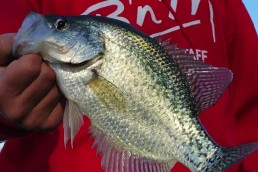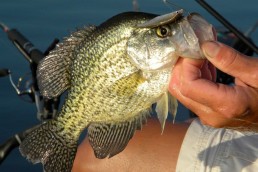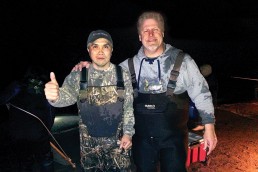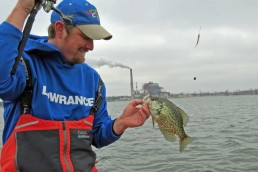Chasing Westwood Run Crappies
SHARE THIS POST
Hoosier crappie honey holes are like morel mushroom spots—both are a secret and often carried to the grave. So, I was just a little surprised when crappie pro-fisherman and guide Damon Phillips called and asked if I wanted to go after some huge black crappies lurking a lake not far from Indianapolis. Phillips claimed to know where slabs were approaching 3 pounds.
When I met with Phillips I had my doubts because I know how Hoosiers guard their secret spots. But I also knew he works hard to put his clients on huge crappies. Also, as a tournament angler I knew he must know how these fish are reacting in relation to weather, temperature and available habitat.
I was a bit excited when Phillips told me that the alleged black crappie honey hole was Westwood Run Lake in Henry County. The 173-acre, trolling motor-only impoundment is a favorite with kayak anglers. Aside from being a beautiful setting, the lake has produced monster bass and nice channel catfish for years. One of the main problems that shore anglers encounter in the summer is the thick weed growth. This keeps all but the most intrepid anglers away. But those same submerged weeds also make for prime black crappie feeding areas.
While white crappies prefer minnows, black crappies prefer insects. The submerged weeds are great for insects, and therefore perfect for black crappies. That’s not to say that a black crappie won’t take an offered minnow, but it does mean that anglers need to target the black crappies a little differently.
Crappies relate to structure, and Westwood Run has lots of hidden structure that causal anglers can’t find. It takes a rig like Phillips runs to find it, and he uses his fish finder to see the schools of crappies relating to stumps along the old creek channel and around submerged brush piles.
But as the water warms, the sex drive of the crappie causes it to head for the shallows to spawn. However, don’t time Westwood Run as you would other lakes in the area. Its water runs clearer than many Indiana lakes, which means the water doesn’t absorb the sunlight as rapidly so spawning can be delayed. And since the water is so clear, crappies may spawn deeper than other more heavily stained lakes.
Westwood Run is shaped like a boot, with the ramp placed on the vamp of the boot. There are multiple areas to access:
Are you enjoying this post?
You can be among the first to get the latest info on where to go, what to use and how to use it!
Area 1: The boot heel holds great crappies due to structure like stumps, submerged timer and brush piles. There is also a shallow point that runs toward the lake’s center. Before the submerged weeds take over the lake, this area is a great staging area for pre-spawn crappies.
In early May, look for fish along the shallow edges because they will still be spawning. If all you are catching is the tuxedo-black males on the nest, move a little farther out and you’ll most likely find the females. “The females will wait for just the right conditions to move up,” Phillips says. “Generally, a water temperature of 58 to 62 degrees triggers the spawn.”
But Phillips warns that the temperature shown on any fish finder is surface temperature, and not actual lake temperature, which can be much colder. This can cause anglers to look for spawning crappies too soon.
Area 2: Look for more submerged brush piles; watch for laydowns along the shoreline. While many may be in later stages of breakup, freshly fallen trees will have more top growth left that attracts crappie. Again, a modern side-imaging and down-imaging fish finders can locate the structure easily.
Area 3: Since the longest portion of Westwood Run Lake has a north-south orientation, the angle of the sun has a tendency to warm the northern sides of bays and other areas sooner than the southern sides. In the case of Westwood Run, the shallows are in the northernmost part of the lake, and therefore more likely to be several degrees warmer than other areas of the lake. This can make all the difference for finding crappies and other fish. But watch the weather a week in advance for the area before hitting the water. A warm rain can accelerate the water temperature upward, while a colder rain could cause creeks to dump frigid water into the lake and shutdown the bite.
Later in May, once the spawn is over and the submerged weed growth has increased, crappie anglers will need to troll or cast baits along the weedline. Larger fish will patrol the edges looking for a free meal. Don’t pass by the dense weed mats. Use a long stiff-action crappie pole to dip your baits straight down into visible holes. Casting to them is futile; the bait must be presented in a vertical presentation and then you can pull the crappie straight up and out once it’s hooked.
I suppose you’re wondering if we ever found a 3-pound crappie. Well, that’s like asking if we had found dinner plate-sized morels. I’m not going to answer the crappie question because you may not believe me. We’ve given you the information to go find those monster slabs, so go look for yourself. Just don’t tell anyone what you find.
MWO
SHARE THIS POST
Did you enjoy this post?
You can be among the first to get the latest info on where to go, what to use and how to use it!
Alan Garbers
Alan J. Garbers is an award-winning author and loves exploring the BWCAW in northern Minnesota, the deserts of Arizona, and the mountains of Colorado. He has lived in Minnesota, Hawaii, Mississippi, Florida, Colorado, Arizona, and Indiana. From hunting rattlesnakes to black bears, and fishing for catfish to muskies, he loves it all.



